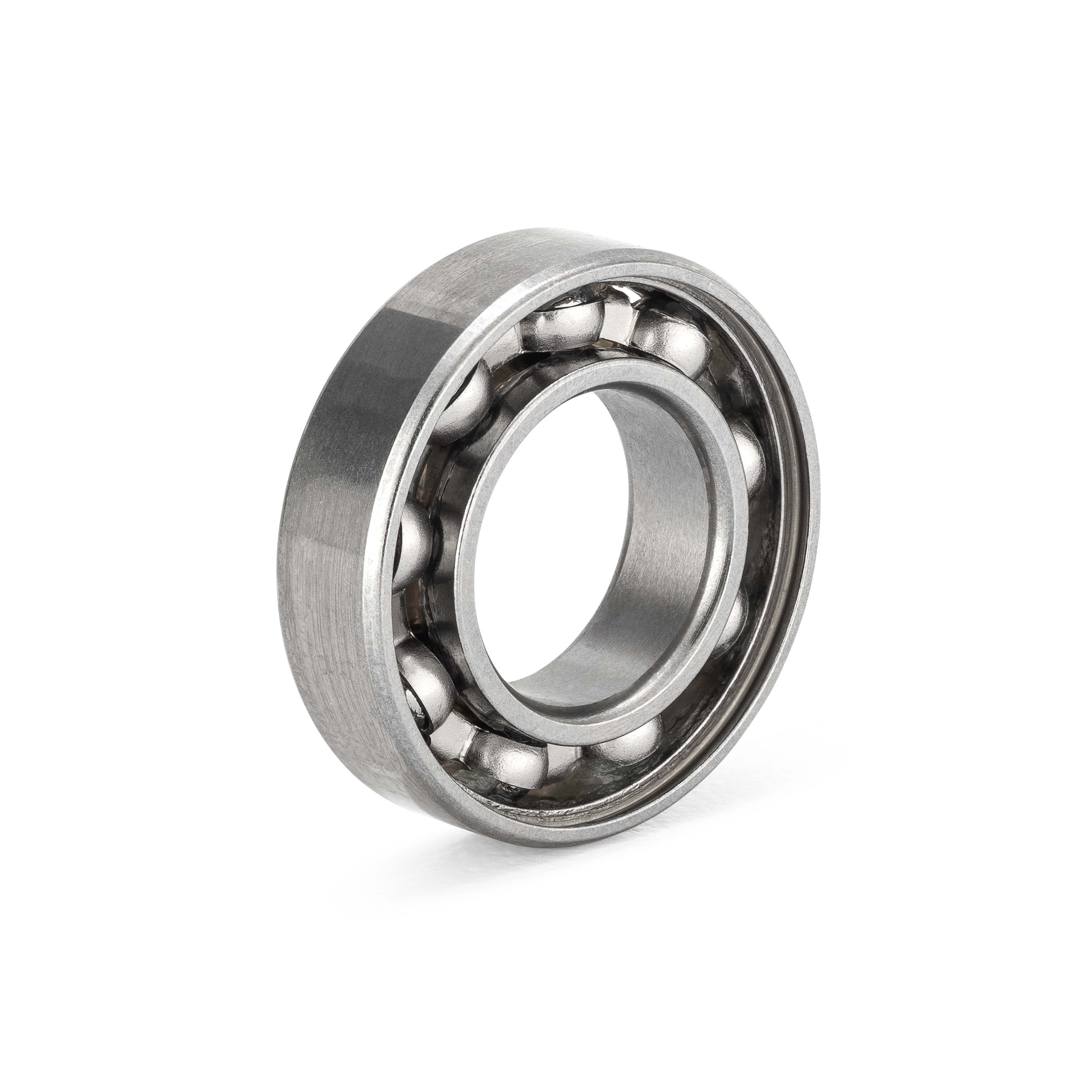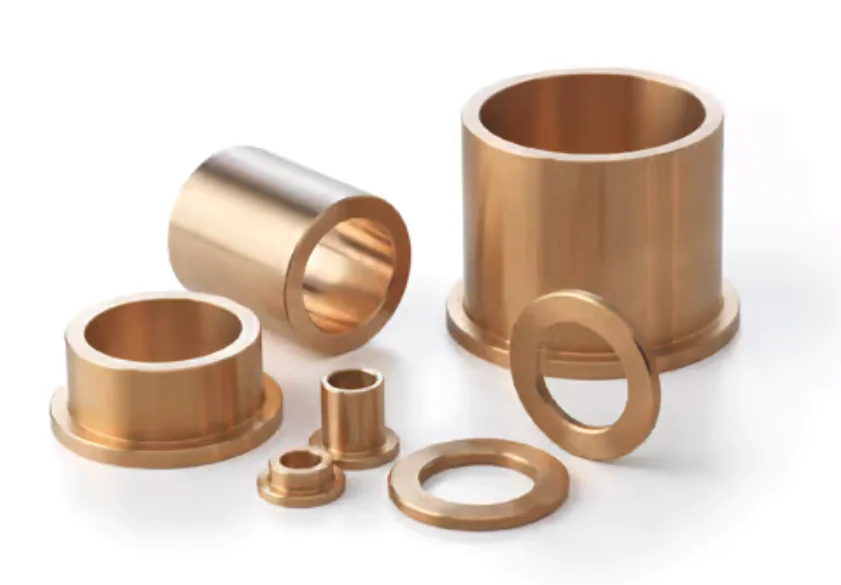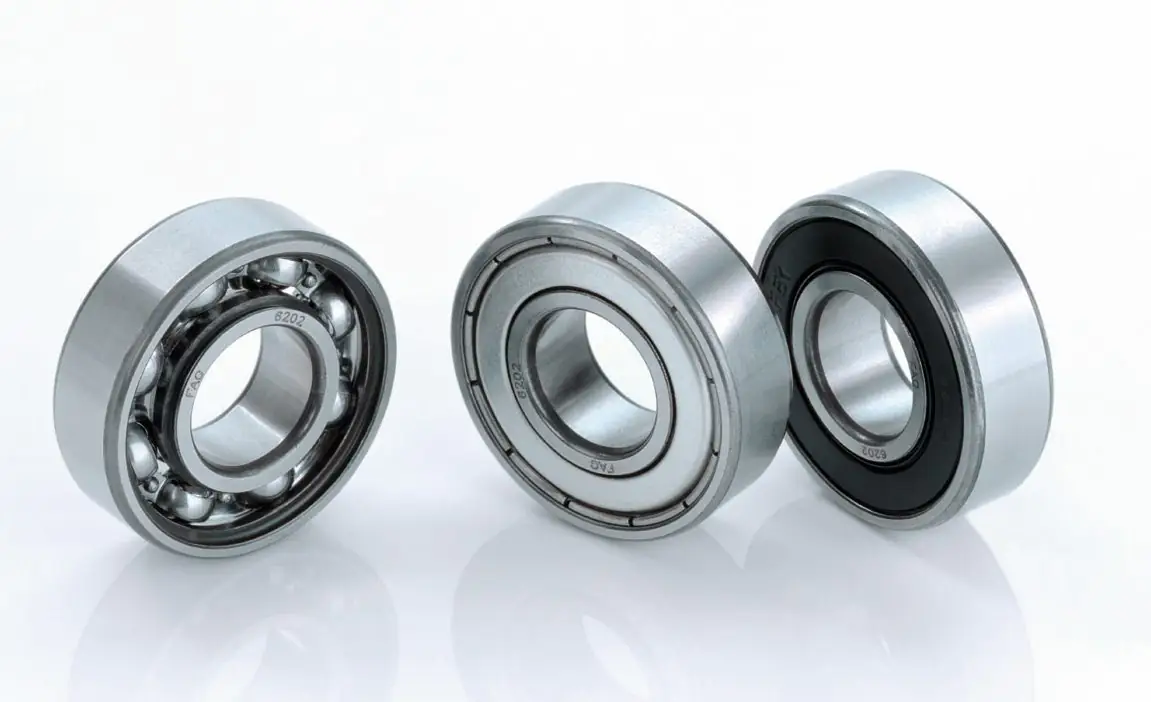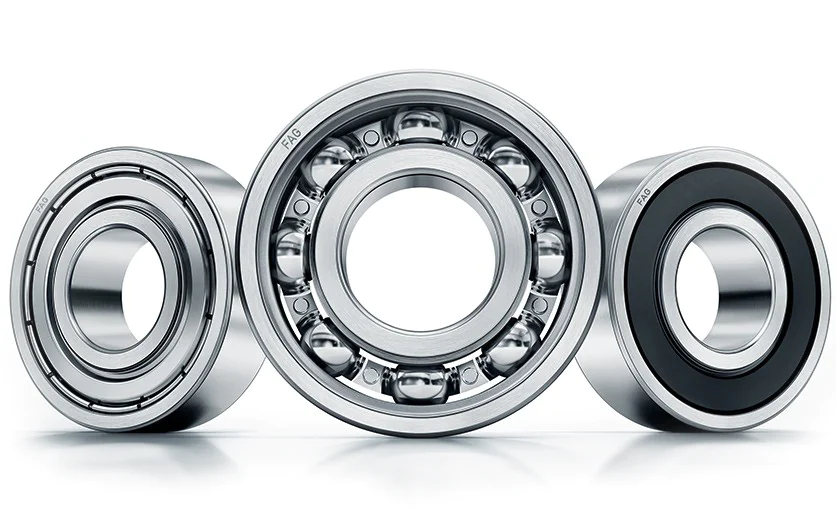
Roller Bearing vs. Ball Bearing: What’s the Difference
What are Ball and Roller Bearings?
Ball and roller bearings are machine elements that are used in all kinds of machines and devices with rotating parts. Their properties have frequently contributed greatly to technical and economic progress in different branches of engineering. Standardization of bearings has made it possible for designs to be chosen directly from bearing tables in the manufacturers’ bearing catalogs. Companies like SKF, NTN, NMB, TPI, Timken, FAG, Schaeffler, INA and many others are natural sources for selection of information. Much of the time the designer is able to select stock bearing products for his design directly from the catalog. Choosing popular and widely used designs facilitates the best availability and provides the most economical solution.
What is the Difference Between Ball and Roller Bearings?
Generally speaking ball and roller bearings may be divided into two main groups: radial bearings and thrust bearings. The basic difference between roller and ball bearings lies in their basic design.The main difference between roller and ball bearings is the rolling element being either a roller or a ball. Roller bearings use tapered, needle, spherical and cylindrical rollers. Radial ball bearings use a round ball as its rolling element. Both roller and ball bearings may have a separator or cage.
Since most types of radial bearings carry some thrust load and some thrust bearings can carry radial load, no apparent division line between the main groups exist, however, one main difference is that for bearings considered as radial ball bearings the carrying capacity is given in catalogs as pure radial load. For Roller or Ball thrust bearings the carrying capacity is given as pure thrust load. If your application calls for pure radial loads then your first choice is a radial ball bearing. If your application has both radial and thrust loads it is then possible to choose the optimal bearing based on basic ratings given.
The Advantages and Disadvantages of Ball Bearings
Advantages
- Low Friction Coefficient: Ball bearings exhibit lower starting and running friction, ideal for high-speed applications.
- Compact Design: They require less space and can be used in smaller mechanisms.
- Versatility: Suitable for both radial and axial (thrust) loads.
- Low Maintenance: They have a longer lifespan in applications with less axial load and require less frequent maintenance.
Disadvantages
- Load Capacity: Limited capacity to handle heavy radial loads compared to roller bearings.
- Durability: Can deform under excessive loads, leading to reduced bearing life.
- Sensitivity: More vulnerable to misalignment and shock loads.
The Advantages and Disadvantages of Roller Bearings
Advantages
- Higher Load Capacity: Due to line contact, roller bearings can support heavier radial loads.
- Variety of Designs: Different designs like cylindrical, tapered, spherical, and needle cater to various applications.
- Durability: Robust in handling heavier loads without deforming.
- Less Sensitivity: More resistant to shock loads and misalignment compared to ball bearings.
Disadvantages
- Friction: Typically has a slightly higher coefficient of friction compared to ball bearings.
- Size: Generally bulkier, requiring more space in machinery.
- Maintenance: Might require more frequent maintenance, especially in high-speed applications due to increased friction.
Which bearing is more efficient?
Both ball and roller bearings are designed to reduce rotational friction while supporting radial and axial loads. However, their efficiency and effectiveness depend on specific applications:
- Ball bearings are generally better for applications that may require high-speed rotation. They have a lower coefficient of friction at startup and during operation, which means they can reach higher speeds with less resistance.
- Roller bearings, on the other hand, are more suitable for applications that demand higher load capacities. This is because the line contact (rather than point contact in ball bearings) allows for a broader distribution of the load across the bearing.
In terms of efficiency, ball bearings often tend to have a slight edge when it comes to minimizing friction at high speeds. However, roller bearings can handle larger loads more effectively due to their design.
Different Types of Ball Bearings
There are two basic types of ball bearings. Ball bearings are classified as either single or double row. The most popular is the single row deep groove type. Single row consists of one row of balls traveling in a single grooved pathway. Double row consists of two rows of balls in two sets of grooved raceways. Both single and double row ball bearings consist of an inner race, outer race, balls and cage . Both types of bearings can support high radial and axial loads. Deep groove ball bearings are used in both low and high-speed applications depending on tolerance class, lubrication, internal clearance, and type of seals or shields selected.
The cage separating the balls spaces them evenly around the periphery. Due to the cage, a ball bearing usually becomes a self-contained unit so that it can be easily mounted or dismounted. In the design of deep groove ball bearings, the grooves are relatively deep and the degree of osculation between ball and raceways is very high. Osculation occurs when two smooth curved surfaces touch. In bearings, the degree of osculation is said to be high if a principal radius of curvature of Body 1 is in the same plane and has the same direction, and almost the same length, as a principal radius of Body 2. If these radii differ appreciably in length the degree of osculation is said to be low.

To assemble the bearing the balls are placed between the rings in an eccentric position relative to one another. The balls are then spread evenly around the circumference, the cage is inserted and riveted. Due to the relatively large size of the balls and their high degree of osculation with the rings, the bearing has a comparatively high load-carrying capacity in both radial and axial directions. The ball bearing performs well in applications with combined loads and especially in high-speed designs and is often more satisfactory for carrying thrust loads than thrust bearings.
A radial ball bearing referred to as the “Conrad type” is made with a filling slot cut axially through the shoulders into the grooves. This arrangement allows the introduction of more balls as permitted between the rings as much as the pitch circumference allows. Since the filling slot must reach to the area of the center of the groove, the bearing cannot be subjected to any large thrust loads as the balls could come in contact with the edges of the filling slot. What is the advantage of adding extra balls in this design? The added balls in the Conrad type ball bearings are used to provide an extra load carry capability in the same envelope dimension.
Roller bearings are generally designed with a cage separating the rollers. There are various types of roller bearings: cylindrical rollers, spherical rollers and tapered rollers, journal roller and needle rollers. Roller bearings have many application uses but generally are used for slower, heavier loads however some cylindrical roller bearings are used in high-speed applications when they meet a high-precision standard. Roller bearing kinematics and low friction make cylindrical roller bearings very suitable for high speeds.

What is a Spherical Roller Bearing?

Spherical roller bearings are particularly suitable for carrying high loads. The common type is a double row design with both rows of rollers having a common spherical raceway in the outer ring so the bearing is completely self-aligning in the same manner as is the self-aligning ball bearing. The rollers are barrel shaped with one end smaller than the other. Consequently, they are pushed against the center guide flange with a force that though small is sufficient to hold the larger end surface of the rollers in continuous contact with the flange, thus making the guiding effective.
What are Cylindrical Roller Bearings?

Cylindrical roller bearings are guided between flanges either on the inner or outer ring. They are held together with the guiding ring by the cage even when the free ring is removed. In the most common type of cylindrical roller bearing, the free ring has no flanges so that within certain limits the bearing rings may be displaced axially in relation to each other. If the bearing is rotating this displacement takes place without resistance provided the rate of displacement is relatively slow (e.g. displacement as a result of temperature expansion of the shaft). The low friction of cylindrical roller bearings make them suitable for relatively high speeds and often used in conjunction with high speed Angular Contact ball bearings in high speed machine spindles.
What is the Difference Between Tapered Roller and Ball Bearings?
As with all roller bearings the tapered roller bearing has a line contact versus a ball type bearing with point contact. Line contact has higher load carrying capacity whereas the ball bearing has a higher speed capacity.
Tapered roller bearings consist of a cup and cone whereas a ball bearing consists of an outer and inner ring. Tapered roller can be assembled as a cartridge but in its simplest form is two separate components while a ball bearing can be separable it is most often a self contained unit.
Tapered roller bearings use straight tapered rollers whose end surfaces contact the guide flange on the inner ring. The taper of the rollers and inner ring roller path have a common apex on the bearing axis. The outer ring in the design has a slightly curved roller path generatrix in order to prevent edge loading of the rollers. In spite of the reduced degree of osculation between roller and outer ring, the outer ring is less strained than the inner ring. The guide flange of the inner ring has a spherical surface against which the spherical end surface of the roller presses. As with a spherical bearing, this pressure against the flange effectively guides the roller. Some manufacturers like Timken, FAG, NTN and SKF make the end surface of the roller flat and the guide surface of the flange conical. The roller end then contacts the roller flange at only two points.
Since tapered roller bearings are separable they are usually mounted opposed so that one bearing is adjusted against one another. After this adjustment a certain very small clearance always is left in the bearing. Temperature variations in the shaft influence this adjustment and thus also the bearing clearance. For this reason single row tapered roller bearings are generally used only where the spacing is short. A tapered roller bearing has a high-load carry capacity radially, as well as axially in one direction. The thrust capacity is dependent upon the angularity of the rollers. As a measure of this angle (contact angle) is usually given as 12 to 16 degrees. Some heavy duty tapered roller bearings have contact angles of 28-30 degrees.

In many applications tapered roller bearings are used in back-to-back pairs so that axial forces can be supported equally in either direction. Tapered roller bearings are widely used in automotive vehicle wheel bearings handling radial and axial loads. Tapered roller bearings are often used in heavy duty applications. Many different industries including agricultural, construction and mining equipment, axle systems, gear box, engine motors and gear reducers, propeller shafts, railroad axle-boxes, differentials, wind turbines and trailers of all types.
Tapered Roller Bearing
Design consideration and selection are dependent upon a number of considerations whether to specify roller or ball bearings into your design.
- Boundary dimensions are a determinate in selection of a rolling bearing whether ball or roller type. With standardized ready to mount roller and ball bearing designs the designer must determine the required size based upon required envelope dimensions. Standard ball and roller bearings have met a universal international standard and are easily identifiable in manufacturers catalogs. Manufacturers like SKF, NTN, NSK,FAG, INA,NMB, TPI are some of the best resources having reliable quality.
- Consideration and understanding of the ambient and internal temperatures of your application is key. The operating temperature of a bearing arrangement results from its own friction, the friction of seals and possibly, from extraneous sources as well as heat dissipation from adjacent components. The operating temperature of a rolling bearing at medium speed and low load is not high because the bearing friction is small. However in many cases heat in roller bearings can be quite high due to other extraneous heat sources in the application. Some application examples include axle boxes of locomotives, hammer mill, wire mill, vibrating screen, cutter shaft of planing machine, bench drill spindle, horizontal boring spindle, circular saw shaft, blooming and slabbing mill, and backup rolls of hot strip mills.
- Determining loads and speeds required in the application. Whether you need a roller or ball bearing it is necessary to consider dimensions, loads and speeds required for every application. Dimensional constraints can be determined by review of standard catalog part numbers. Once dimensions are determined, load ratings, speeds and operating environment must be considered. Different materials used in manufacturing both radial ball bearings and roller type bearings can be specified for each operating circumstance.
Data in the catalog will be used to select which bearing is best suited whether roller bearing, ball bearing or tapered roller bearing. Life calculations can be made and optimal bearing selection can be accomplished by contacting your bearing supplier.
There are many considerations in finding the right roller or ball bearing and with the aid of a competent bearing specialist a proper bearing can be selected. It is important to find a bearing supplier that has a (CBS) certified bearing specialist on staff.
Choosing the Right Bearing for Your Application
Selecting the correct bearing improves efficiency, reliability, and service life . This guide provides a technical comparison, with proven industry data and plain-text descriptions, to help you choose between ball and roller bearings in real-world settings.
Key Principle
Ball bearings are best for applications that require low friction and high speed. Roller bearings excel where machines encounter heavy or shock loads.
Comparative Data: Ball vs Roller Bearings
| Bearing Type | Dynamic Load Rating (Cr) | Max Speed Limit* | Friction Coefficient** | Misalignment Tolerance | Typical Applications |
| Ball Bearing | 0.67x vs. roller | 1.5x roller (up to 30,000 RPM for a 6205) | 0.001–0.0015 | Low (0.04–0.08°) | Electric motors, fans |
| Roller Bearing | Up to 3x higher (at same size) | 0.6x ball (up to 12,000 RPM for a 6205 size) | 0.002–0.004 | Moderate-high (up to 0.5°) | Gearboxes, conveyors, trucks |
*Based on 25mm bore, oil lubrication
**Typical under lubricated, steady-state use
- Example: For 25 mm bore, SKF 6205 ball bearing: Cr ≈ 19.5 kN, max speed ≈ 30,000 RPM.
NU205 roller bearing (same bore): Cr ≈ 30 kN, max speed ≈ 12,000 RPM.
Ball bearings move faster but carry smaller loads. Roller bearings handle more weight but spin slower.
Load and Speed Requirements
Load Profile
- Ball bearings handle light to moderate loads. Not ideal for heavy machinery.
- Roller bearings support much heavier loads. Excellent for impact or shock.
Speed
- Ball bearings shine at very high speeds. Perfect for electric motors, fans, and dental drills.
- Roller bearings in many cases are not your first choice for high speed. Use them in gearboxes, conveyors, or heavy axles.
Bearing Life Calculation
A bearing’s expected life can be estimated with the standard L10 formula:
L10 = (C/P)^p × (10^6)/(60 × n)
- C = dynamic load rating (kN)
- P = applied load (kN)
- n = RPM
- p = exponent (3 for ball bearings, 10/3 for roller bearings)
Example:
5 kN load, 1800 RPM:
- Ball (6205): L10 ≈ 34,000 hours
- Roller (NU205): L10 ≈ 71,000 hours
Higher load ratings mean longer life at the same load.
Industries That Use Ball and Roller Bearings
Bearings are critical in many different applications. The selection for which type—ball or roller—depends on the unique needs of each. Here’s a detailed overview for some applications.
Automotive Industry
Where bearings are applied:
- Wheel hubs, transmissions, engines, alternators, air conditioning systems, and drive shafts.
How they’re used:
- Roller bearings are found in wheel hubs and transmissions because they handle heavy loads, shock, and side forces from driving and road conditions.
- Ball bearings are used for lighter, high-speed needs like electric motors (alternators, fans).
Why it matters: these bearings keep vehicles moving safely, quietly, and efficiently—helping prevent breakdowns and supporting smoother rides.
Industrial Machinery
Where bearings are used:
- Conveyor systems, gearboxes, pumps, compressors, mills, and machine tools.
How they’re used:
- Roller bearings take on the weight and strain in heavy-duty machines, conveyors, and presses.
- Ball bearings are ideal for electric motors, precision tools, and high-speed rotating parts.
Why it matters: reliable bearings mean less downtime and smoother, longer-lasting operations in factories and production lines.
Aerospace
Where bearings are used:
- Jet engines, landing gear, flight controls, turbines, fuel pumps, actuators.
How they’re used:
- Ball bearings are chosen for high-speed spinning parts like turbines, often in hybrid ceramic designs to resist heat and low weight.
- Roller bearings are relied on for heavy-duty spots—landing gear, control surfaces—where loads and shocks are tough.
Why it matters: top-quality bearings are critical for flight safety, precise control, and performance under extreme temperatures and speeds.
Medical Equipment
Where bearings are used:
- MRI machines, dental tools, surgical robots, lab centrifuges, prosthetics.
How they’re used:
- Ball bearings are favored for medical devices that need to run very smoothly, quietly, and precisely—such as imaging scanners or handpieces.
- Specialty bearings (ceramic, stainless) stand up to frequent cleaning, sterilization, and corrosion risks.
Why it matters: accurate, quiet, and reliable bearings are vital where patient safety and comfort are at stake.
Railway and Transportation
Where bearings are used:
- Train wheels, axles, gearboxes, traction motors.
How they’re used:
- Roller bearings carry massive loads from train cars and rails, handling shocks and long service intervals.
- Ball bearings may be used in onboard electric motors.
Why it matters: reliable quality bearings keep trains safe and running over vast distances and rough tracks.
Renewable Energy
Where bearings are used:
- Wind turbine blades, gearboxes, generators, hydroelectric plants.
How they’re used:
- Roller bearings support large, slow-turning shafts in wind and hydro turbines, sustaining heavy loads for years.
- Ball bearings support high-speed generator shafts.
Why it matters: long-lasting bearings reduce maintenance and make renewable power production more efficient.
Consumer Electronics and Appliances
Where bearings are used:
- Fans, washing machines, blenders, hard drives.
How they’re used:
- Ball bearings lower friction and noise in fast-spinning parts like cooling fans and small motors.
Why it matters:
Quiet, low-vibration bearings improve comfort and reliability in everyday products.
Industry Use Cases
Automotive
- Wheel hubs: Roller bearings (handle 20–80 kN loads)
- Alternators: Ball bearings (run at 12,000–18,000 RPM)
Industrial Equipment
- Conveyor rollers: Roller bearings (loads >50 kN)
- Electric motors: Ball bearings (often >8,000 RPM)
Aerospace
- Turbines: Hybrid ceramic ball bearings (speeds up to 40,000 RPM, high temps)
- Landing gear: Roller or spherical roller bearings (support heavy shock during landing)
Medical Devices
- Dental tools: Miniature ball bearings (speeds up to 400,000 RPM)
- MRI/CT: Ceramic ball bearings (for non-magnetic, precise motion)
Both ball and roller bearings are essential across industries, each chosen for their respective strengths. Selection depends on loads, speeds, space, and environment—ensuring machines everywhere run smoothly, efficiently, and with less risk of failure.
Frequently Asked Questions
Do ball bearings reduce friction better than roller bearings?
Ball bearings generate less friction than roller bearings when they’re under light or moderate loads. Their point-contact design lets them spin with minimal resistance. Roller bearings spread the load across a line, making them better for heavier weights, but they create a bit more friction as a result. If your main concern is smooth motion at low to medium loads, ball bearings are usually the best choice. PIB Sales carries a range of both styles to fit these needs.
Can I use roller bearings in place of ball bearings?
Interchanging ball bearings for roller bearings isn’t always a simple endeavor. Roller bearings handle heavier loads and reduce wear in difficult environments. However, they’re bulkier and less suited for high speeds. If your application places high demands on load, size, and speed, check the specs first. The experts at PIB Sales can help you pick the right bearing for your exact requirements.
What is better for high-speed applications?
Ball bearings most of the time out-perform roller bearings at high speeds. Their small contact points keep them cool and reduce friction. This allows them to spin faster and last longer. Roller bearings handle heavier loads and due to their larger contact area limits speed. For motors, fans, and similar uses, PIB Sales recommends ball bearings for fast, steady performance.
Contact PIB bearing specialists today to help with your selection.


